MD4064 Research Proposal: Impact of FDI and Trade on India's Economy
VerifiedAdded on 2023/06/12
|18
|3830
|90
Report
AI Summary
This research proposal investigates the impact of Foreign Direct Investment (FDI) and trade dynamics on India's economic growth. It begins with an introduction to India's economic landscape, highlighting its growth post-liberalization in 1991. The proposal outlines research questions focusing on the relationship between FDI, trade, and economic prosperity, and whether the benefits extend to all sectors. The literature review examines existing debates on the contributions of FDI, including its positive implications for industrial development and job creation, as well as negative impacts like the destruction of domestic industries. The research methodology adopts a positivist philosophy, using quantitative data and statistical analysis. It details the data collection methods, analysis techniques, potential limitations, and ethical considerations. Finally, the proposal includes a research timetable, providing a structured plan for the study. This assignment is available on Desklib, a platform offering a range of study tools and resources for students.

Running head: RESEARCH PROPOSAL
Research Proposal
Name of the Student
Name of the University
Author Note
Research Proposal
Name of the Student
Name of the University
Author Note
Paraphrase This Document
Need a fresh take? Get an instant paraphrase of this document with our AI Paraphraser
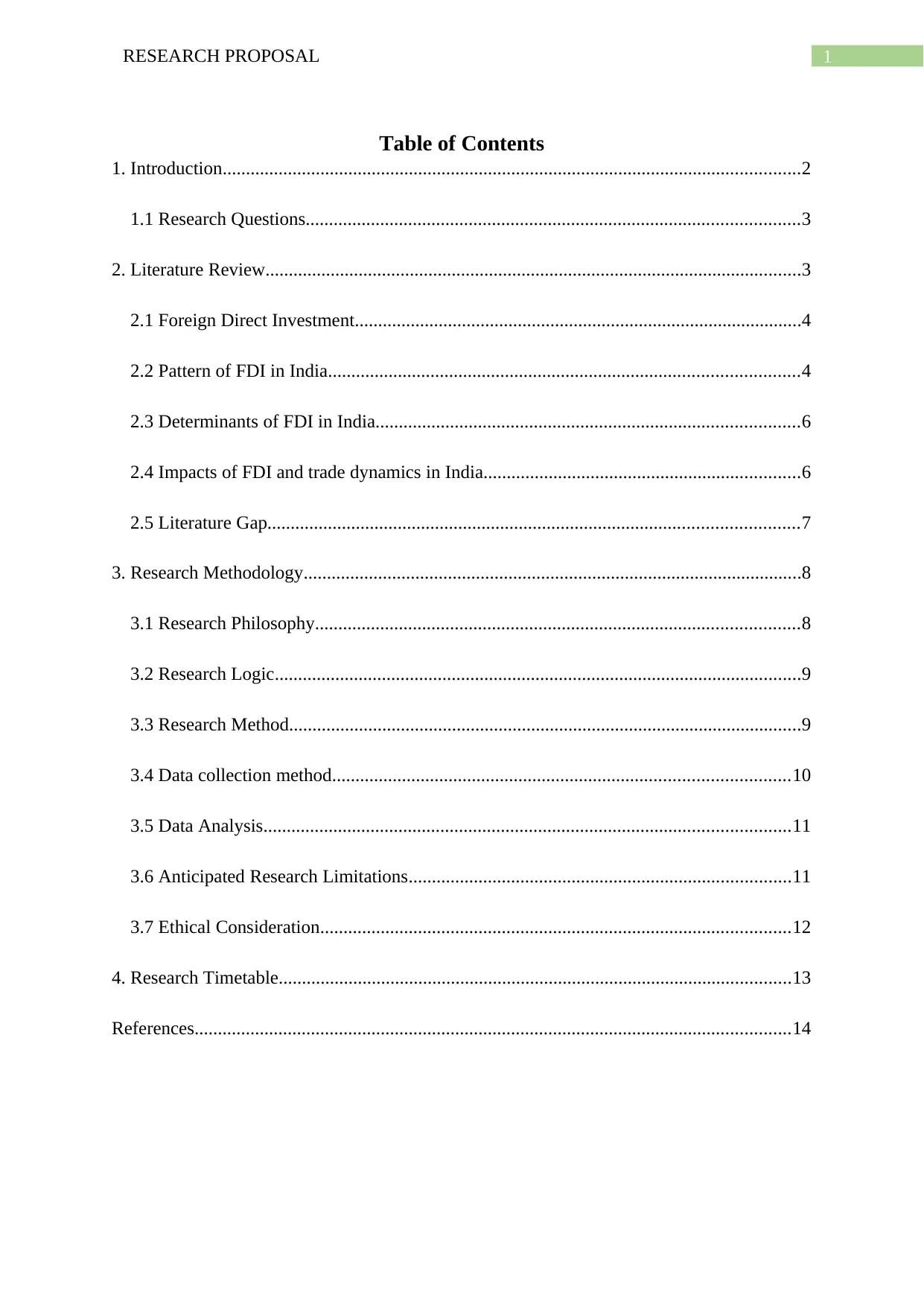
1RESEARCH PROPOSAL
Table of Contents
1. Introduction............................................................................................................................2
1.1 Research Questions..........................................................................................................3
2. Literature Review...................................................................................................................3
2.1 Foreign Direct Investment................................................................................................4
2.2 Pattern of FDI in India.....................................................................................................4
2.3 Determinants of FDI in India...........................................................................................6
2.4 Impacts of FDI and trade dynamics in India....................................................................6
2.5 Literature Gap..................................................................................................................7
3. Research Methodology...........................................................................................................8
3.1 Research Philosophy........................................................................................................8
3.2 Research Logic.................................................................................................................9
3.3 Research Method..............................................................................................................9
3.4 Data collection method..................................................................................................10
3.5 Data Analysis.................................................................................................................11
3.6 Anticipated Research Limitations..................................................................................11
3.7 Ethical Consideration.....................................................................................................12
4. Research Timetable..............................................................................................................13
References................................................................................................................................14
Table of Contents
1. Introduction............................................................................................................................2
1.1 Research Questions..........................................................................................................3
2. Literature Review...................................................................................................................3
2.1 Foreign Direct Investment................................................................................................4
2.2 Pattern of FDI in India.....................................................................................................4
2.3 Determinants of FDI in India...........................................................................................6
2.4 Impacts of FDI and trade dynamics in India....................................................................6
2.5 Literature Gap..................................................................................................................7
3. Research Methodology...........................................................................................................8
3.1 Research Philosophy........................................................................................................8
3.2 Research Logic.................................................................................................................9
3.3 Research Method..............................................................................................................9
3.4 Data collection method..................................................................................................10
3.5 Data Analysis.................................................................................................................11
3.6 Anticipated Research Limitations..................................................................................11
3.7 Ethical Consideration.....................................................................................................12
4. Research Timetable..............................................................................................................13
References................................................................................................................................14

2RESEARCH PROPOSAL
⊘ This is a preview!⊘
Do you want full access?
Subscribe today to unlock all pages.

Trusted by 1+ million students worldwide
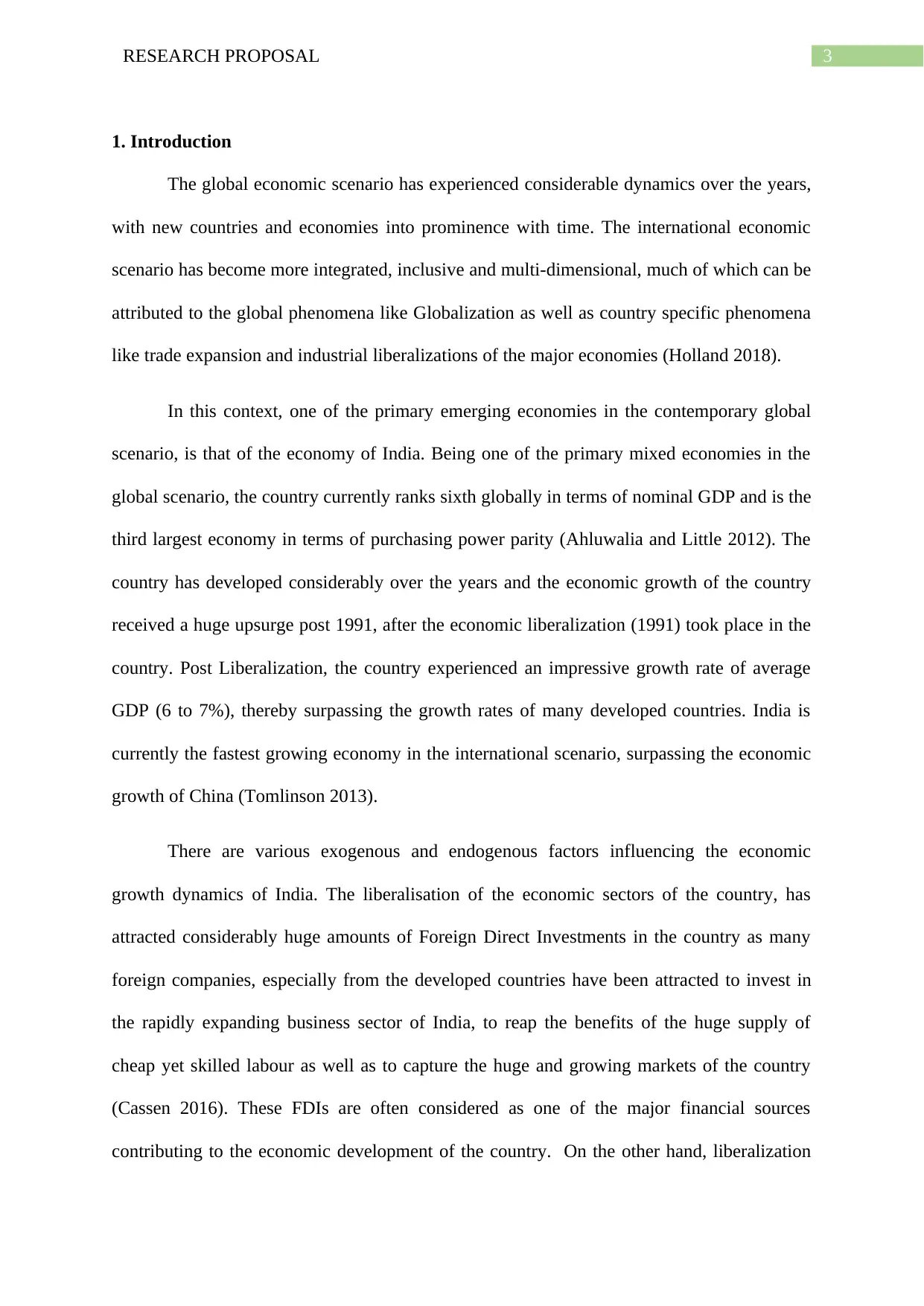
3RESEARCH PROPOSAL
1. Introduction
The global economic scenario has experienced considerable dynamics over the years,
with new countries and economies into prominence with time. The international economic
scenario has become more integrated, inclusive and multi-dimensional, much of which can be
attributed to the global phenomena like Globalization as well as country specific phenomena
like trade expansion and industrial liberalizations of the major economies (Holland 2018).
In this context, one of the primary emerging economies in the contemporary global
scenario, is that of the economy of India. Being one of the primary mixed economies in the
global scenario, the country currently ranks sixth globally in terms of nominal GDP and is the
third largest economy in terms of purchasing power parity (Ahluwalia and Little 2012). The
country has developed considerably over the years and the economic growth of the country
received a huge upsurge post 1991, after the economic liberalization (1991) took place in the
country. Post Liberalization, the country experienced an impressive growth rate of average
GDP (6 to 7%), thereby surpassing the growth rates of many developed countries. India is
currently the fastest growing economy in the international scenario, surpassing the economic
growth of China (Tomlinson 2013).
There are various exogenous and endogenous factors influencing the economic
growth dynamics of India. The liberalisation of the economic sectors of the country, has
attracted considerably huge amounts of Foreign Direct Investments in the country as many
foreign companies, especially from the developed countries have been attracted to invest in
the rapidly expanding business sector of India, to reap the benefits of the huge supply of
cheap yet skilled labour as well as to capture the huge and growing markets of the country
(Cassen 2016). These FDIs are often considered as one of the major financial sources
contributing to the economic development of the country. On the other hand, liberalization
1. Introduction
The global economic scenario has experienced considerable dynamics over the years,
with new countries and economies into prominence with time. The international economic
scenario has become more integrated, inclusive and multi-dimensional, much of which can be
attributed to the global phenomena like Globalization as well as country specific phenomena
like trade expansion and industrial liberalizations of the major economies (Holland 2018).
In this context, one of the primary emerging economies in the contemporary global
scenario, is that of the economy of India. Being one of the primary mixed economies in the
global scenario, the country currently ranks sixth globally in terms of nominal GDP and is the
third largest economy in terms of purchasing power parity (Ahluwalia and Little 2012). The
country has developed considerably over the years and the economic growth of the country
received a huge upsurge post 1991, after the economic liberalization (1991) took place in the
country. Post Liberalization, the country experienced an impressive growth rate of average
GDP (6 to 7%), thereby surpassing the growth rates of many developed countries. India is
currently the fastest growing economy in the international scenario, surpassing the economic
growth of China (Tomlinson 2013).
There are various exogenous and endogenous factors influencing the economic
growth dynamics of India. The liberalisation of the economic sectors of the country, has
attracted considerably huge amounts of Foreign Direct Investments in the country as many
foreign companies, especially from the developed countries have been attracted to invest in
the rapidly expanding business sector of India, to reap the benefits of the huge supply of
cheap yet skilled labour as well as to capture the huge and growing markets of the country
(Cassen 2016). These FDIs are often considered as one of the major financial sources
contributing to the economic development of the country. On the other hand, liberalization
Paraphrase This Document
Need a fresh take? Get an instant paraphrase of this document with our AI Paraphraser

4RESEARCH PROPOSAL
has also facilitated extensive trade and commerce between India and other significant
economics of the world. However, there lies debate regarding their roles and positive as well
as negative implications on the economic dynamics of the country. Keeping this into
consideration, the concerned research proposes to analyse and interpret the impacts and
implications (both positive as well as negative) of the inflow of FDI and the trade activities of
India on the growth dynamics of the economy of the country.
1.1 Research Questions
The primary research question which the concerned paper aims to focus on is as
follows:
How has the economic growth of India been affected over the years, by the dynamics in
FDI and the trade sector of the country?
Keeping the primary question into consideration, there are several secondary and
specific questions which the research focusses upon, which are as follows:
a) Is greater inflow of foreign direct investment directly or inversely related with the
economic growth of the country?
b) Is the expansion of international trade relations directly or inversely related with the
economic prosperity of the country?
c) Has the economic growth (if any) due to inflow of FDI and trade expansion
percolated in developing all the sectors of the economy of the country?
2. Literature Review
There have been considerable debates regarding the contributions of the Foreign
Direct Investment, which have been increasingly inflowing in India, especially from the
developed commercial economies. On one hand while some economists point towards the
positive implications of the same as one of the primary stimulus in the industrial and
has also facilitated extensive trade and commerce between India and other significant
economics of the world. However, there lies debate regarding their roles and positive as well
as negative implications on the economic dynamics of the country. Keeping this into
consideration, the concerned research proposes to analyse and interpret the impacts and
implications (both positive as well as negative) of the inflow of FDI and the trade activities of
India on the growth dynamics of the economy of the country.
1.1 Research Questions
The primary research question which the concerned paper aims to focus on is as
follows:
How has the economic growth of India been affected over the years, by the dynamics in
FDI and the trade sector of the country?
Keeping the primary question into consideration, there are several secondary and
specific questions which the research focusses upon, which are as follows:
a) Is greater inflow of foreign direct investment directly or inversely related with the
economic growth of the country?
b) Is the expansion of international trade relations directly or inversely related with the
economic prosperity of the country?
c) Has the economic growth (if any) due to inflow of FDI and trade expansion
percolated in developing all the sectors of the economy of the country?
2. Literature Review
There have been considerable debates regarding the contributions of the Foreign
Direct Investment, which have been increasingly inflowing in India, especially from the
developed commercial economies. On one hand while some economists point towards the
positive implications of the same as one of the primary stimulus in the industrial and

5RESEARCH PROPOSAL
commercial development of the country, thereby contributing to overall economic welfare of
the country as a whole, the other group of economists and scholars put forward a more
pessimistic view regarding the negative implications of expansion of trade and inflow of FDI
in the country. keeping this into consideration, this section of the proposal tries to conduct an
extensive review of the existing literatures and empirically supported scholarly articles
present in this aspect, in order to analyse the impacts of the concerned attributes on the
overall economic growth of the country in consideration.
2.1 Foreign Direct Investment
Moran (2012) defines the phenomenon of Foreign Direct Investment as the inflow of
investment in businesses of a country from an investor or investors of some other country,
such that the foreign investors have the control over the local company or businesses in
which they invest. The author also points towards the fact that this FDI has been one of the
primary components of economic prosperity and development of many countries, especially
the developing ones, many of which have been emerging as potentially dominant economies
in the global scenario.
The companies which make foreign investments are popularly known as the
Multinational Corporations (Alfaro and Johnson 2012). In this context, Jones and Wren
(2016), indicates towards the two possible ways in which the foreign MNCs invest in the
companies or businesses in some other countries. According to the authors, FDI can be in the
form of “Greenfield Investment”, where the MNCs make direct investments by creation of a
foreign institution as a whole, or else in the form of direct acquisition of the foreign
enterprise as a whole which is known as “Brownfield Investment” (Gatzert and Kosub 2014).
commercial development of the country, thereby contributing to overall economic welfare of
the country as a whole, the other group of economists and scholars put forward a more
pessimistic view regarding the negative implications of expansion of trade and inflow of FDI
in the country. keeping this into consideration, this section of the proposal tries to conduct an
extensive review of the existing literatures and empirically supported scholarly articles
present in this aspect, in order to analyse the impacts of the concerned attributes on the
overall economic growth of the country in consideration.
2.1 Foreign Direct Investment
Moran (2012) defines the phenomenon of Foreign Direct Investment as the inflow of
investment in businesses of a country from an investor or investors of some other country,
such that the foreign investors have the control over the local company or businesses in
which they invest. The author also points towards the fact that this FDI has been one of the
primary components of economic prosperity and development of many countries, especially
the developing ones, many of which have been emerging as potentially dominant economies
in the global scenario.
The companies which make foreign investments are popularly known as the
Multinational Corporations (Alfaro and Johnson 2012). In this context, Jones and Wren
(2016), indicates towards the two possible ways in which the foreign MNCs invest in the
companies or businesses in some other countries. According to the authors, FDI can be in the
form of “Greenfield Investment”, where the MNCs make direct investments by creation of a
foreign institution as a whole, or else in the form of direct acquisition of the foreign
enterprise as a whole which is known as “Brownfield Investment” (Gatzert and Kosub 2014).
⊘ This is a preview!⊘
Do you want full access?
Subscribe today to unlock all pages.

Trusted by 1+ million students worldwide
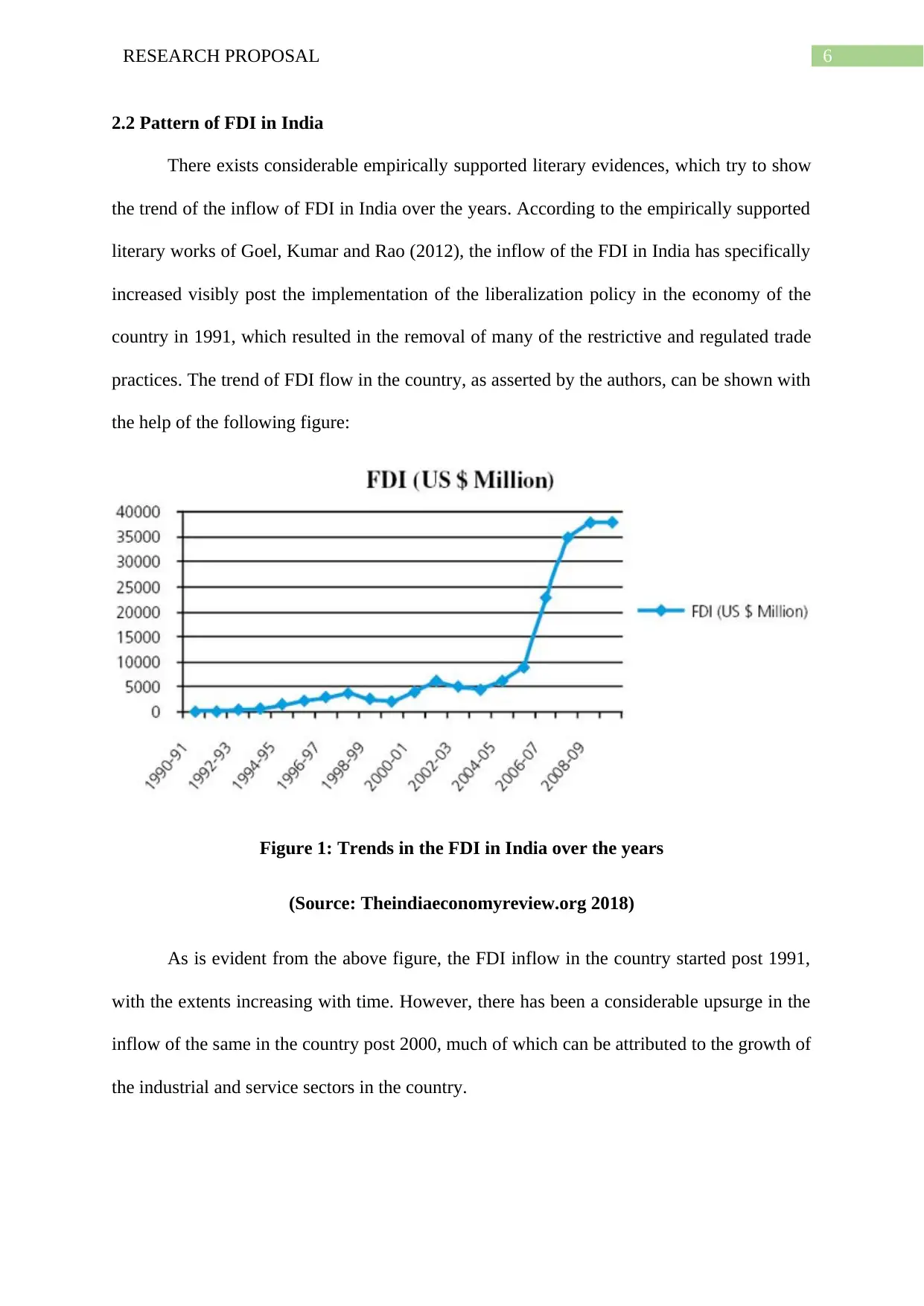
6RESEARCH PROPOSAL
2.2 Pattern of FDI in India
There exists considerable empirically supported literary evidences, which try to show
the trend of the inflow of FDI in India over the years. According to the empirically supported
literary works of Goel, Kumar and Rao (2012), the inflow of the FDI in India has specifically
increased visibly post the implementation of the liberalization policy in the economy of the
country in 1991, which resulted in the removal of many of the restrictive and regulated trade
practices. The trend of FDI flow in the country, as asserted by the authors, can be shown with
the help of the following figure:
Figure 1: Trends in the FDI in India over the years
(Source: Theindiaeconomyreview.org 2018)
As is evident from the above figure, the FDI inflow in the country started post 1991,
with the extents increasing with time. However, there has been a considerable upsurge in the
inflow of the same in the country post 2000, much of which can be attributed to the growth of
the industrial and service sectors in the country.
2.2 Pattern of FDI in India
There exists considerable empirically supported literary evidences, which try to show
the trend of the inflow of FDI in India over the years. According to the empirically supported
literary works of Goel, Kumar and Rao (2012), the inflow of the FDI in India has specifically
increased visibly post the implementation of the liberalization policy in the economy of the
country in 1991, which resulted in the removal of many of the restrictive and regulated trade
practices. The trend of FDI flow in the country, as asserted by the authors, can be shown with
the help of the following figure:
Figure 1: Trends in the FDI in India over the years
(Source: Theindiaeconomyreview.org 2018)
As is evident from the above figure, the FDI inflow in the country started post 1991,
with the extents increasing with time. However, there has been a considerable upsurge in the
inflow of the same in the country post 2000, much of which can be attributed to the growth of
the industrial and service sectors in the country.
Paraphrase This Document
Need a fresh take? Get an instant paraphrase of this document with our AI Paraphraser
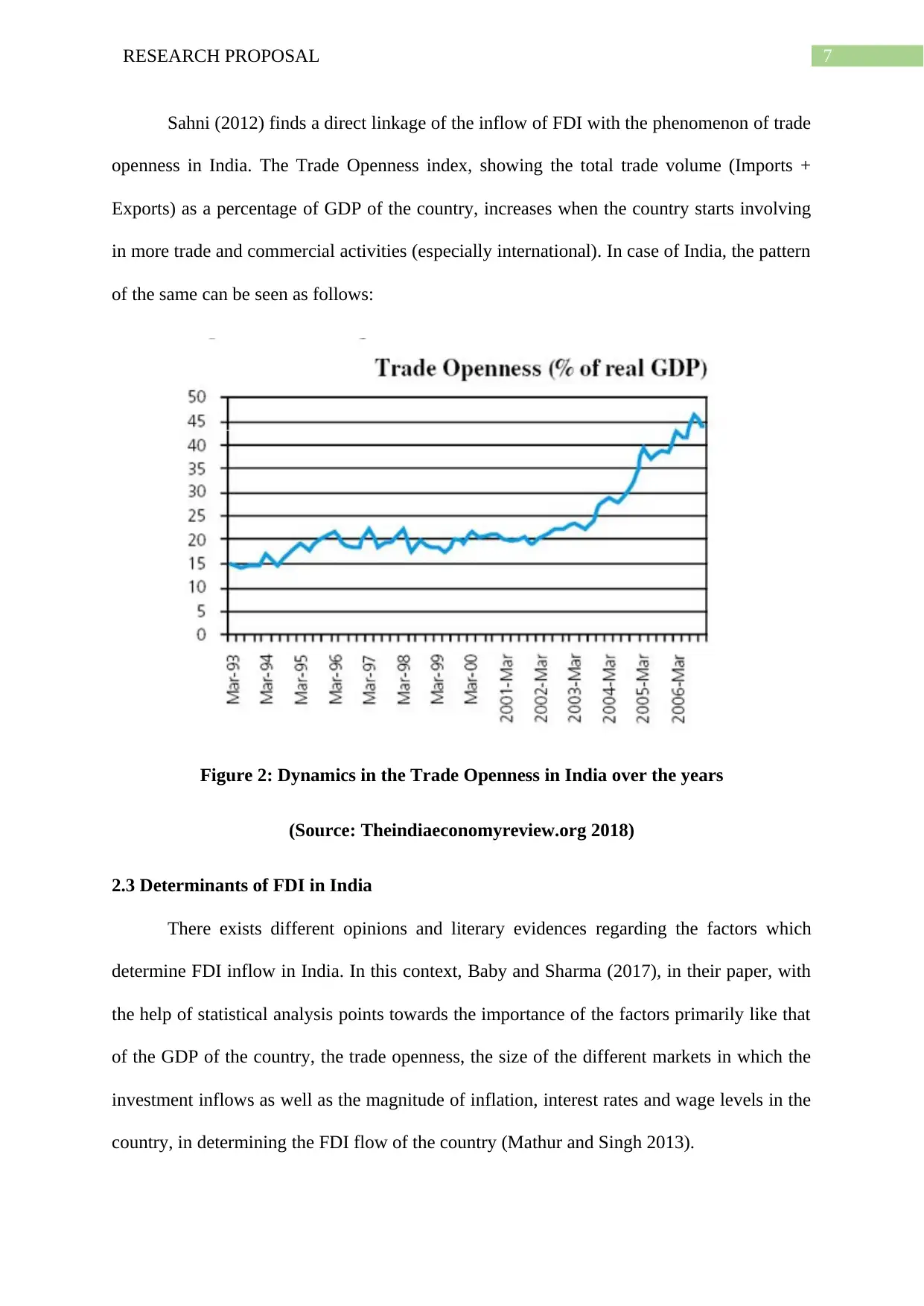
7RESEARCH PROPOSAL
Sahni (2012) finds a direct linkage of the inflow of FDI with the phenomenon of trade
openness in India. The Trade Openness index, showing the total trade volume (Imports +
Exports) as a percentage of GDP of the country, increases when the country starts involving
in more trade and commercial activities (especially international). In case of India, the pattern
of the same can be seen as follows:
Figure 2: Dynamics in the Trade Openness in India over the years
(Source: Theindiaeconomyreview.org 2018)
2.3 Determinants of FDI in India
There exists different opinions and literary evidences regarding the factors which
determine FDI inflow in India. In this context, Baby and Sharma (2017), in their paper, with
the help of statistical analysis points towards the importance of the factors primarily like that
of the GDP of the country, the trade openness, the size of the different markets in which the
investment inflows as well as the magnitude of inflation, interest rates and wage levels in the
country, in determining the FDI flow of the country (Mathur and Singh 2013).
Sahni (2012) finds a direct linkage of the inflow of FDI with the phenomenon of trade
openness in India. The Trade Openness index, showing the total trade volume (Imports +
Exports) as a percentage of GDP of the country, increases when the country starts involving
in more trade and commercial activities (especially international). In case of India, the pattern
of the same can be seen as follows:
Figure 2: Dynamics in the Trade Openness in India over the years
(Source: Theindiaeconomyreview.org 2018)
2.3 Determinants of FDI in India
There exists different opinions and literary evidences regarding the factors which
determine FDI inflow in India. In this context, Baby and Sharma (2017), in their paper, with
the help of statistical analysis points towards the importance of the factors primarily like that
of the GDP of the country, the trade openness, the size of the different markets in which the
investment inflows as well as the magnitude of inflation, interest rates and wage levels in the
country, in determining the FDI flow of the country (Mathur and Singh 2013).

8RESEARCH PROPOSAL
2.4 Impacts of FDI and trade dynamics in India
There lies substantial debate regarding whether FDI inflow in India has been
beneficial for the country or whether the same has brought negative implications on the
economy of the same. Malhotra (2014), in his empirically evidenced and supported work
points towards the contribution of the inflow of FDI in India over the years, in terms of
creation of industrial prospects, which in turn has resulted in the creation of jobs in these
newly prospering industries in the country. The author also asserts towards the fact that the
increase in the job opportunities, owing to this inflow of FDI has led to an overall
improvement in the quality of life of the people in the country.
Supporting this view, Mahalakshmi, Thiyagarajan and Naresh (2015), augments the
same by suggesting that the inflow of FDI and a related increase in the trade activities of the
country has also led to the inflow technological and infrastructural innovations in the country,
which in turn has led to the creation of more capital efficiency and accountability of the
nation. This in turn has also led to a trickle-down effect and a multi-lateral implication, which
can be seen from the overall improvement in the quality of life, educational prospects as well
as prevalence of healthy competition in the country. Ray (2012), points towards the positive
implications of the same in the aspects of higher consumer saving, higher wages, increase in
the revenue of the government and similar attributes.
However, on the other hand, Bose (2012), highlights the problems which have been
created by these inflow of FDI and expansion of trade prospects of the country. According to
the author, the negative impacts of the same can be seen in the destruction of the domestic
industries and small entrepreneurs, in the shrinking of the subsistence sector as well as
indigenous job creations and political instability and creation of lobby, which have been
prominent in the contemporary economic domains of the country.
2.4 Impacts of FDI and trade dynamics in India
There lies substantial debate regarding whether FDI inflow in India has been
beneficial for the country or whether the same has brought negative implications on the
economy of the same. Malhotra (2014), in his empirically evidenced and supported work
points towards the contribution of the inflow of FDI in India over the years, in terms of
creation of industrial prospects, which in turn has resulted in the creation of jobs in these
newly prospering industries in the country. The author also asserts towards the fact that the
increase in the job opportunities, owing to this inflow of FDI has led to an overall
improvement in the quality of life of the people in the country.
Supporting this view, Mahalakshmi, Thiyagarajan and Naresh (2015), augments the
same by suggesting that the inflow of FDI and a related increase in the trade activities of the
country has also led to the inflow technological and infrastructural innovations in the country,
which in turn has led to the creation of more capital efficiency and accountability of the
nation. This in turn has also led to a trickle-down effect and a multi-lateral implication, which
can be seen from the overall improvement in the quality of life, educational prospects as well
as prevalence of healthy competition in the country. Ray (2012), points towards the positive
implications of the same in the aspects of higher consumer saving, higher wages, increase in
the revenue of the government and similar attributes.
However, on the other hand, Bose (2012), highlights the problems which have been
created by these inflow of FDI and expansion of trade prospects of the country. According to
the author, the negative impacts of the same can be seen in the destruction of the domestic
industries and small entrepreneurs, in the shrinking of the subsistence sector as well as
indigenous job creations and political instability and creation of lobby, which have been
prominent in the contemporary economic domains of the country.
⊘ This is a preview!⊘
Do you want full access?
Subscribe today to unlock all pages.

Trusted by 1+ million students worldwide
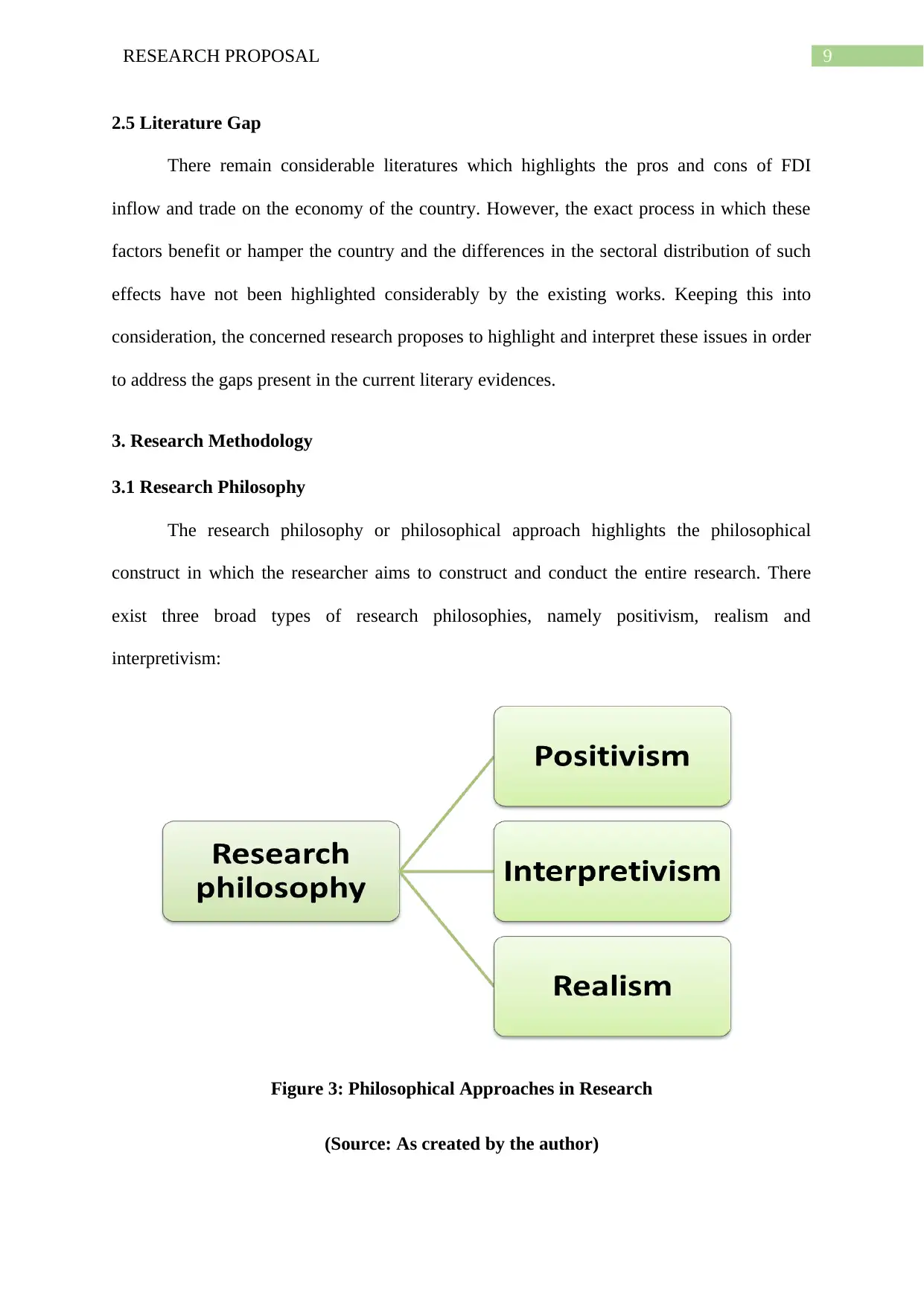
9RESEARCH PROPOSAL
2.5 Literature Gap
There remain considerable literatures which highlights the pros and cons of FDI
inflow and trade on the economy of the country. However, the exact process in which these
factors benefit or hamper the country and the differences in the sectoral distribution of such
effects have not been highlighted considerably by the existing works. Keeping this into
consideration, the concerned research proposes to highlight and interpret these issues in order
to address the gaps present in the current literary evidences.
3. Research Methodology
3.1 Research Philosophy
The research philosophy or philosophical approach highlights the philosophical
construct in which the researcher aims to construct and conduct the entire research. There
exist three broad types of research philosophies, namely positivism, realism and
interpretivism:
Figure 3: Philosophical Approaches in Research
(Source: As created by the author)
2.5 Literature Gap
There remain considerable literatures which highlights the pros and cons of FDI
inflow and trade on the economy of the country. However, the exact process in which these
factors benefit or hamper the country and the differences in the sectoral distribution of such
effects have not been highlighted considerably by the existing works. Keeping this into
consideration, the concerned research proposes to highlight and interpret these issues in order
to address the gaps present in the current literary evidences.
3. Research Methodology
3.1 Research Philosophy
The research philosophy or philosophical approach highlights the philosophical
construct in which the researcher aims to construct and conduct the entire research. There
exist three broad types of research philosophies, namely positivism, realism and
interpretivism:
Figure 3: Philosophical Approaches in Research
(Source: As created by the author)
Paraphrase This Document
Need a fresh take? Get an instant paraphrase of this document with our AI Paraphraser
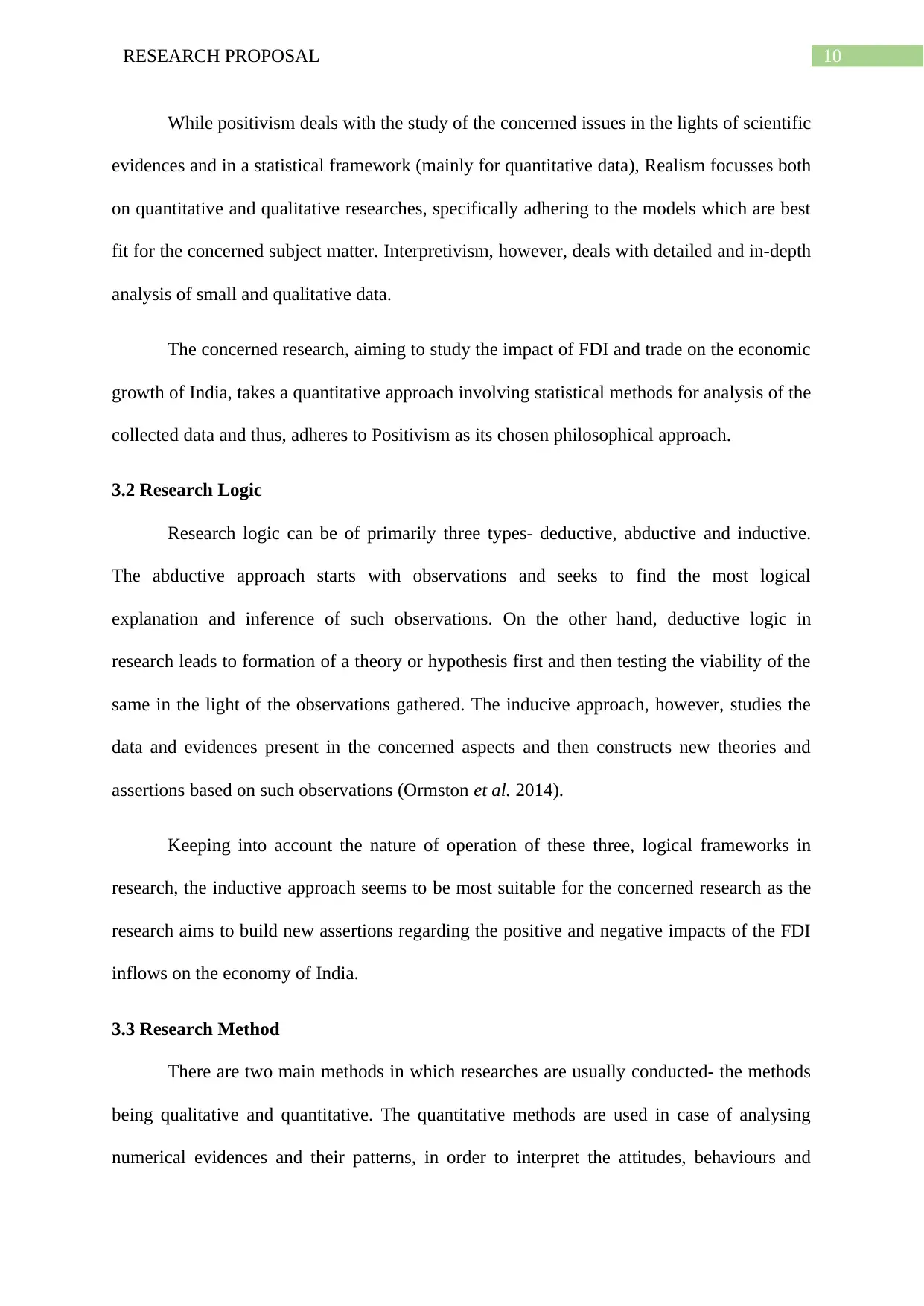
10RESEARCH PROPOSAL
While positivism deals with the study of the concerned issues in the lights of scientific
evidences and in a statistical framework (mainly for quantitative data), Realism focusses both
on quantitative and qualitative researches, specifically adhering to the models which are best
fit for the concerned subject matter. Interpretivism, however, deals with detailed and in-depth
analysis of small and qualitative data.
The concerned research, aiming to study the impact of FDI and trade on the economic
growth of India, takes a quantitative approach involving statistical methods for analysis of the
collected data and thus, adheres to Positivism as its chosen philosophical approach.
3.2 Research Logic
Research logic can be of primarily three types- deductive, abductive and inductive.
The abductive approach starts with observations and seeks to find the most logical
explanation and inference of such observations. On the other hand, deductive logic in
research leads to formation of a theory or hypothesis first and then testing the viability of the
same in the light of the observations gathered. The inducive approach, however, studies the
data and evidences present in the concerned aspects and then constructs new theories and
assertions based on such observations (Ormston et al. 2014).
Keeping into account the nature of operation of these three, logical frameworks in
research, the inductive approach seems to be most suitable for the concerned research as the
research aims to build new assertions regarding the positive and negative impacts of the FDI
inflows on the economy of India.
3.3 Research Method
There are two main methods in which researches are usually conducted- the methods
being qualitative and quantitative. The quantitative methods are used in case of analysing
numerical evidences and their patterns, in order to interpret the attitudes, behaviours and
While positivism deals with the study of the concerned issues in the lights of scientific
evidences and in a statistical framework (mainly for quantitative data), Realism focusses both
on quantitative and qualitative researches, specifically adhering to the models which are best
fit for the concerned subject matter. Interpretivism, however, deals with detailed and in-depth
analysis of small and qualitative data.
The concerned research, aiming to study the impact of FDI and trade on the economic
growth of India, takes a quantitative approach involving statistical methods for analysis of the
collected data and thus, adheres to Positivism as its chosen philosophical approach.
3.2 Research Logic
Research logic can be of primarily three types- deductive, abductive and inductive.
The abductive approach starts with observations and seeks to find the most logical
explanation and inference of such observations. On the other hand, deductive logic in
research leads to formation of a theory or hypothesis first and then testing the viability of the
same in the light of the observations gathered. The inducive approach, however, studies the
data and evidences present in the concerned aspects and then constructs new theories and
assertions based on such observations (Ormston et al. 2014).
Keeping into account the nature of operation of these three, logical frameworks in
research, the inductive approach seems to be most suitable for the concerned research as the
research aims to build new assertions regarding the positive and negative impacts of the FDI
inflows on the economy of India.
3.3 Research Method
There are two main methods in which researches are usually conducted- the methods
being qualitative and quantitative. The quantitative methods are used in case of analysing
numerical evidences and their patterns, in order to interpret the attitudes, behaviours and
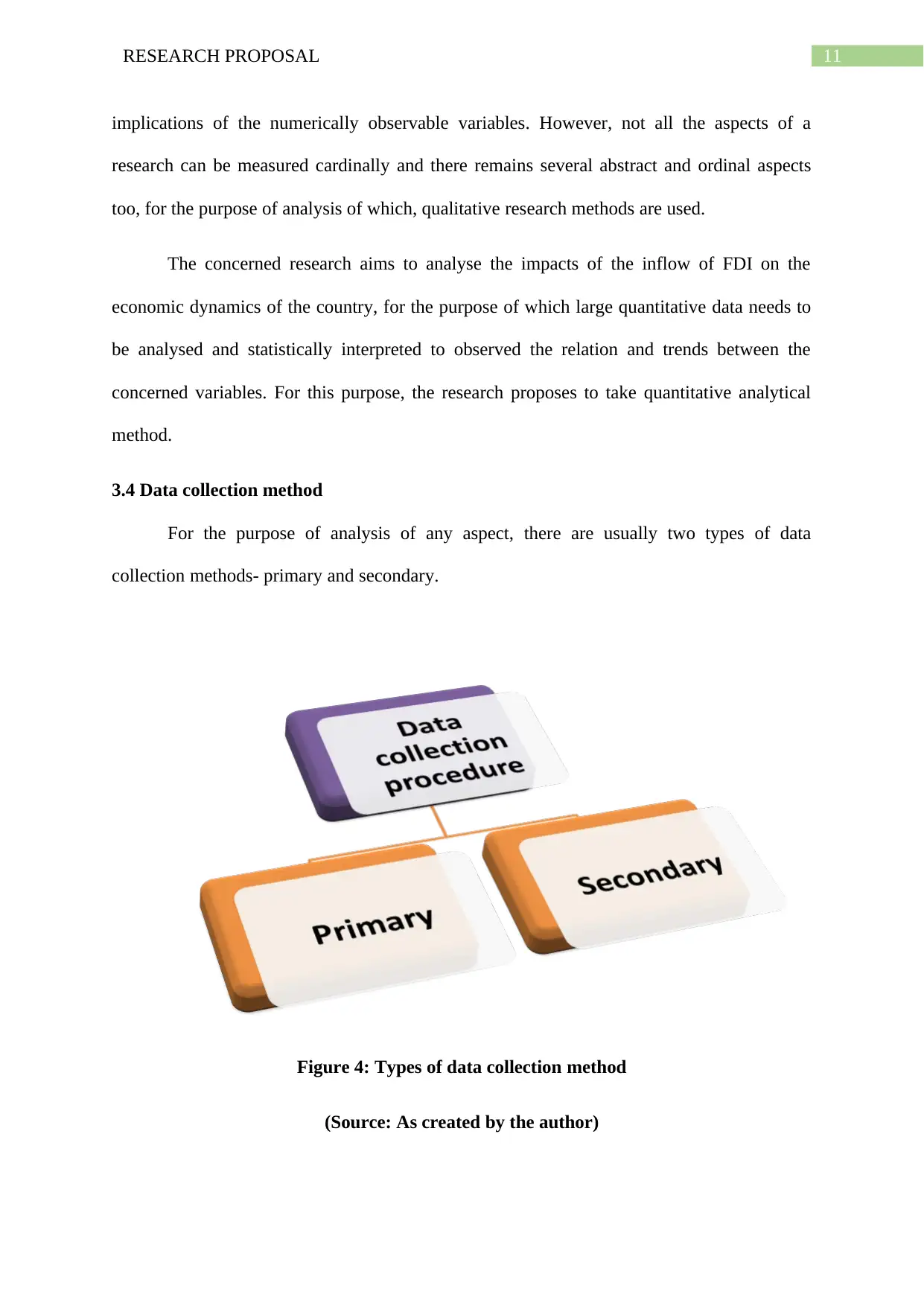
11RESEARCH PROPOSAL
implications of the numerically observable variables. However, not all the aspects of a
research can be measured cardinally and there remains several abstract and ordinal aspects
too, for the purpose of analysis of which, qualitative research methods are used.
The concerned research aims to analyse the impacts of the inflow of FDI on the
economic dynamics of the country, for the purpose of which large quantitative data needs to
be analysed and statistically interpreted to observed the relation and trends between the
concerned variables. For this purpose, the research proposes to take quantitative analytical
method.
3.4 Data collection method
For the purpose of analysis of any aspect, there are usually two types of data
collection methods- primary and secondary.
Figure 4: Types of data collection method
(Source: As created by the author)
implications of the numerically observable variables. However, not all the aspects of a
research can be measured cardinally and there remains several abstract and ordinal aspects
too, for the purpose of analysis of which, qualitative research methods are used.
The concerned research aims to analyse the impacts of the inflow of FDI on the
economic dynamics of the country, for the purpose of which large quantitative data needs to
be analysed and statistically interpreted to observed the relation and trends between the
concerned variables. For this purpose, the research proposes to take quantitative analytical
method.
3.4 Data collection method
For the purpose of analysis of any aspect, there are usually two types of data
collection methods- primary and secondary.
Figure 4: Types of data collection method
(Source: As created by the author)
⊘ This is a preview!⊘
Do you want full access?
Subscribe today to unlock all pages.

Trusted by 1+ million students worldwide
1 out of 18
Related Documents
Your All-in-One AI-Powered Toolkit for Academic Success.
+13062052269
info@desklib.com
Available 24*7 on WhatsApp / Email
![[object Object]](/_next/static/media/star-bottom.7253800d.svg)
Unlock your academic potential
Copyright © 2020–2025 A2Z Services. All Rights Reserved. Developed and managed by ZUCOL.





